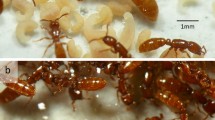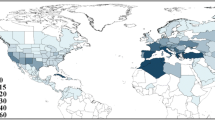Abstract
The ant subfamily Dorylinae consists of the true army ants and non-army ant genera. The biology of these non-army ants is important in discussing the evolution of the army ant adaptive syndrome. We report on the colony composition, morphological characteristics, and phasic reproduction of a non-army doryline ant Cerapachys sulcinodis species complex collected in northern Thailand. Colony size was up to 1850 workers, which is larger than that of other non-army doryline ants. Unlike the true army ants, most colonies were polygynous. The queens were ergatoid (permanently wingless) and distinctively larger than the workers, but morphological specialization was not as strong as in army ant queens. The workers showed large variation in body size, but they have no distinctive subcastes like many genera of true army ants. These biological characteristics indicated that the C. sulcinodis complex has an atypical biology which are reminiscent of the army ant adaptive syndrome.








Similar content being viewed by others
Availability of data and material
Data deposited as electronic supplementary materials.
Code availability
R code for morphometric analysis is available as electronic supplementary material.
References
Borowiec ML (2016) Generic revision of the ant subfamily Dorylinae (Hymenoptera, Formicidae). Zookeys 608:1–280. https://doi.org/10.3897/zookeys.608.9427
Borowiec ML (2019) Convergent evolution of the army ant syndrome and congruence in big-data phylogenetics. Syst Biol 68(4):642–656. https://doi.org/10.1093/sysbio/syy088
Brown WLJ (1975) Contributions toward a reclassification of the Formicidae. V. Ponerinae, tribes Platythyreini, Cerapachyini, Cylindromyrmecini, Acanthostichini, and Aenictogitini. Search Agric 5:1–115
Bulmer MG (1983) Sex ratio theory in social insects with swarming. J Theor Biol 100(2):329–339. https://doi.org/10.1016/0022-5193(83)90356-9
Buschnger A, Peeters C, Crozier RH (1989) Life-pattern studies on an Australian Sphinctomyrmex (Formicidae: Ponerinae; Cerapachyini): Functional polygyny, brood periodicity and raiding behavior. Psyche 96:287–300. https://doi.org/10.1155/1989/13614
Eguchi K, Mizuno R, Ito F, Satria R, Van An D, Viet BT, Luong PTH (2016) First discovery of subdichthadiigyne in Yunodorylus Xu, 2000 (Formicidae: Dorylinae). Rev Suisse Zool 123(2):307–314. https://doi.org/10.5281/zenodo.155307
Fisher BL, Peeters C (2019) Ants of Madagascar: a guide to the 62 genera. Assoc Vahatra, Antananarivo
Gotwald WH (1995) Army ants: the biology of social predation. Cornell University Press, Ithaca
Hagan HR (1954) The reproductive system of the army-ant queen, Eciton (Eciton) part 3, the oöcyte cycle. Am Mus Novit 1665:1–20
Heinze J, Buschinger A (1989) Queen polymorphism in Leptothorax spec. A: its genetic and ecological background (Hymenoptera: Formicidae). Insectes Soc 36(2):139–155. https://doi.org/10.1007/BF02225909
Hoang DT, Chernomor O, von Haeseler A, Minh BQ, Vinh LS (2018) UFBoot2: improving the ultrafast bootstrap approximation. Mol Biol Evol 35:518–522. https://doi.org/10.1093/molbev/msx281
Hoenle PO, Blüthgen N, Brückner A, Kronauer DJC, Fiala B, Donoso DA, Smith MA, Jara BO, von Beeren C (2019) Species-level predation network uncovers high prey specificity in a neotropical army ant community. Mol Ecol 28(9):2423–2440. https://doi.org/10.1111/mec.15078
Hölldobler B (1982) Communication, raiding behavior and prey storage in Cerapachys (Hymenoptera; Formicidae). Psyche 89(1–2):3–23. https://doi.org/10.1155/1982/28390
Holliday M (1904) A study of some ergatogynic ants. Zool Jahrb Abt Syst 19:293–328
Idogawa N, Dobata S (2018) Colony structure and life history of Lioponera daikoku (Formicidae: Dorylinae). Asian Myrmecol 10:99. https://doi.org/10.20362/am.010006
Ito F (1997) Colony composition and morphological caste differentiation between ergatoid queens and workers in the ponerine ant genus Leptogenys in the Oriental tropics. Ethol Ecol Evol 9(4):335–343. https://doi.org/10.1080/08927014.1997.9522876
Ito F, Ohkawara K (2000) Production and behavior of ergatoid queens in two species of the Indonesian ponerine ant genus Leptogenys (diminuta-group) (Hymenoptera: Formicidae). Ann Entomol Soc Am 93(4):869–873. https://doi.org/10.1603/0013-8746(2000)093[0869:PABOEQ]2.0.CO;2
Ito F, Jaitrong W, Hashim R, Mizuno R (2018) Colony composition, brood production and caste dimorphism in two species of the doryline genus Lioponera in the Oriental tropics (Formicidae: Dorylinae). Asian Myrmecol 10:e010007. https://doi.org/10.20362/am.010007
Johnson RA (2010) Independent colony founding by ergatoid queens in the ant genus Pogonomyrmex: queen foraging provides an alternative to dependent colony founding. Insectes Soc 57(2):169–176. https://doi.org/10.1007/s00040-010-0065-6
Kalyaanamoorthy S, Minh B, Wong TKF, von Haeseler A, Jermiin LS (2017) ModelFinder: fast model selection for accurate phylogenetic estimates. Nat Methods 14:587–589. https://doi.org/10.1038/nmeth.4285
Keller RA, Peeters C, Beldade P (2014) Evolution of thorax architecture in ant castes highlights trade-off between flight and ground behaviors. Elife 3:e01539. https://doi.org/10.7554/eLife.01539
Kimura M (1980) A simple method for estimating evolutionary rate of base substitutions through comparative studies of nucleotide sequences. J Mol Evol 16:111–120. https://doi.org/10.1007/bf01731581
Kronauer DJC (2009) Recent advances in army ant biology (Hymenoptera: Formicidae). Myrmecol News 12:51–65
Kronauer DJC (2020) Army ants: nature’s ultimate social hunters. Harvard University Press, Cambridge
Kronauer DJC, Boomsma JJ (2007) Multiple queens means fewer mates. Curr Biol 17(17):R753–R755. https://doi.org/10.1016/j.cub.2007.06.057G
Kumar S, Stecher G, Li M, Knyaz C, Tamura K (2018) MEGA X: molecular evolutionary genetics analysis across computing platforms. Mol Biol Evol 35:1547–1549. https://doi.org/10.1093/molbev/msy096
Maschwitz U, Steghaus-Kovac S, Gaube R, Hänel H (1989) A South East Asian ponerine ant of the genus Leptogenys (Hym., Form.) with army ant life habits. Behav Ecol Sociobiol 24(5):305–316. https://doi.org/10.1007/BF00290907
Masuko K (2006) Collection and the result of dissection of the ant Cerapachys humicola. Ari 28:1–6
Minh BQ, Schmidt HA, Chernomor O, Schrempf D, Woodhams MD, von Haeseler A, Lanfear R (2020) IQ-TREE 2: new models and efficient methods for phylogenetic inference in the genomic era. Mol Biol Evol 37:1530–1534. https://doi.org/10.1093/molbev/msaa015
Mizuno R, Suttiprapan P, Jaitrong W, Ito F (2019) Daily and seasonal foraging activity of the oriental non-army ant doryline Cerapachys sulcinodis species complex (Hymenoptera: Formicidae). Sociobiology 66(2):239–246. https://doi.org/10.13102/sociobiology.v66i2.3775
Molet M, Fisher BL, Ito F, Peeters C (2009) Shift from independent to dependent colony foundation and evolution of ‘multi-purpose’ ergatoid queens in Mystrium ants (subfamily Amblyoponinae). Biol J Linn Soc 98(1):198–207. https://doi.org/10.1111/j.1095-8312.2009.01257.x
Pamilo P (1991) Evolution of colony characteristics in social insects. I. Sex allocation. Am Nat 137(1):83–107
Peeters C (2012) Convergent evolution of wingless reproductives across all subfamilies of ants, and sporadic loss of winged queens (Hymenoptera: Formicidae). Myrmecol News 16:75–91
Peeters C, Ito F (2001) Colony dispersal and the evolution of queen morphology in social Hymenoptera. Annu Rev Entomol 46(1):601–630. https://doi.org/10.1146/annurev.ento.46.1.601
Raignier A, van Boven JKA (1955) Etude taxonomique, biologique et biométrique des Dorylus du sous-genre Anomma (Hymenoptera Formicidae). Ann Mus R Congo Belg 2:1–359
Ravary F, Jaisson P (2004) Absence of individual sterility in thelytokous colonies of the ant Cerapachys biroi Forel (Formicidae, Cerapachyinae). Insectes Soc 51(1):67–73. https://doi.org/10.1007/s00040-003-0724-y
R Core Team (2019) R: a language and environment for statistical computing. R Foundation for Statistical Computing, Vienna, Austria. https://www.R-project.org/
Rettenmeyer CW (1963) Behavioral studies of army ants. Univ Kans Sci Bull 44:281–465
Rettenmeyer CW, Watkins JF II (1978) Polygyny and monogyny in army ants (Hymenoptera: Formicidae). J Kans Entomol Soc 51:581–591
Satria R, Kurushima H, Herwina H, Yamane SK, Eguchi K (2015) The trap-jaw ant genus Odontomachus Latreille (Hymenoptera: Formicidae) from Sumatra, with a new species description. Zootaxa 4048(1):1–36. https://doi.org/10.11646/zootaxa.4048.1.1
Satria R, Itioka T, Meleng P, Eguchi K (2018) Second discovery of the subdichthadiigyne in Yunodorylus (Borowiec, 2009) (Formicidae: Dorylinae). Rev Suisse Zool 125(1):73–78. https://doi.org/10.5281/zenodo.1196017
Schneirla TC (1956) A preliminary survey of colony division and related processes in two species of terrestrial army ants. Insectes Soc 3(1):49–69
Schneirla TC (1957) Army ants, a study in social organization. W. H. Freeman and company, San Francisco
Schneirla TC (1958) The behavior and biology of certain nearctic army ants last part of the functional season, Southeastern Arizona. Insectes Soc 5(2):215–255
Schneirla TC, Reyes AY (1966) Raiding and related behaviour in two surface-adapted species of the Old World Doryline ant, Aenictus. Anim Behav 14(1):132–148
Snelling GC, Snelling RR (2007) New synonymy, new species, new keys to Neivamyrmex army ants of the United states. Mem Am Entomol Inst 80:459–550
Tschinkel WR (2011) Back to basics: sociometry and sociogenesis of ant societies (Hymenoptera: Formicidae). Myrmecol News 14:49–54
Tsuji K, Yamauchi K (1995) Production of females by parthenogenesis in the ant, Cerapachys biroi. Insectes Soc 42(3):333–336. https://doi.org/10.1007/BF01240430
Tsuji K, Furukawa T, Kinomura K, Takamine H, Yamauchi K (1991) The caste system of the dolichoderine ant Technomyrmex albipes (Hymenoptera: Formicidae): morphological description of queens, workers and reproductively active intercastes. Insectes Soc 38:413–422. https://doi.org/10.1007/BF01241875
Villet M (1989) A syndrome leading to ergatoid queens in ponerine ants (Hymenoptera: Formicidae). J Nat Hist 23(4):825–832. https://doi.org/10.1080/00222938900770431
Villet MH, Crewe RM, Duncan FD (1991) Evolutionary trends in the reproductive biology of ponerine ants (Hymenoptera: Formicidae). J Nat Hist 25(6):1603–1610. https://doi.org/10.1080/00222939100770991
Warton DI, Duursma RA, Falster DS, Taskinen S (2012) smatr 3–an R package for estimation and inference about allometric lines. Methods Ecol Evol 3(2):257–259
Whelden RM (1963) Anatomy of adult queen and workers of army ants Eciton burchelli Westw. and E. hamatum Fabr. (Hymenoptera: Formicidae). J NY Entomol Soc 71:14–30 (90–115, 158–178, 246–261)
Wilson EO (1958) Observations on the behavior of the Cerapachyine ants. Insectes Soc 5:129–140. https://doi.org/10.1007/BF02222432
Wilson EO (1959) Some ecological characteristics of ants in New Guinea rain forests. Ecology 40:437–447
Wilson EO (1959) Studies on the ant fauna of Melanesia VI. The tribe Cerapachyini. Pac Insects 1:39–57
Yamauchi K, Furukawa T, Kinomura K, Takamine H, Tsuji K (1991) Secondary polygyny by inbred wingless sexuals in the dolichoderine ant Technomyrmex albipes. Behav Ecol Sociobiol 29:313–319. https://doi.org/10.1007/BF00165955
Acknowledgements
We are grateful to Mr. Supachai Nuchit and Mr. Pisut Lugsawut, royal project directors at the Omkoi National Forest, Thailand, and all staff of the field station, especially Mr. Natthapol Sornsuparp, for their kind help during our field work. We would like to thank to Dr. Katsuyuki Eguchi for his help in molecular phylogeny, Dr. Johan Billen, Dr. Terry McGlynn and two anonymous referees for careful reading and useful comments, Mr. Dennis Murphy for grammatical review, and Mr. Yudthana Samung for taking specimen pictures. This work was partly supported by grants for overseas research (B, 24405010, 16H05769) and young scientists (20J13490) from Japan Society for the Promotion of Science.
Funding
This work was partly supported by grants for overseas research (B, 24405010, 16H05769) and young scientists (20J13490) from Japan Society for the Promotion of Science.
Author information
Authors and Affiliations
Contributions
FI designed the research; RM, FI and WJ identified ant species; RM, FI, WJ and PS performed field study; AY performed DNA barcoding. RM analyzed the data and wrote the primarily manuscript. All authors contributed critically to the drafts and gave final approval for publication.
Corresponding author
Ethics declarations
Conflicts of interest
Not applicable.
Ethical approval
Not applicable.
Consent to participate (include appropriate statements)
All authors have approved for contribute on the research of this manuscript.
Consent for publication (include appropriate statements)
All authors have approved for submission of this manuscript.
Supplementary Information
Below is the link to the electronic supplementary material.
Rights and permissions
About this article
Cite this article
Mizuno, R., Suttiprapan, P., Jaitrong, W. et al. Colony composition, phasic reproduction, and queen–worker dimorphism of an oriental non-army ant doryline Cerapachys sulcinodis species complex in northern Thailand. Insect. Soc. 69, 19–35 (2022). https://doi.org/10.1007/s00040-021-00841-5
Received:
Revised:
Accepted:
Published:
Issue Date:
DOI: https://doi.org/10.1007/s00040-021-00841-5




